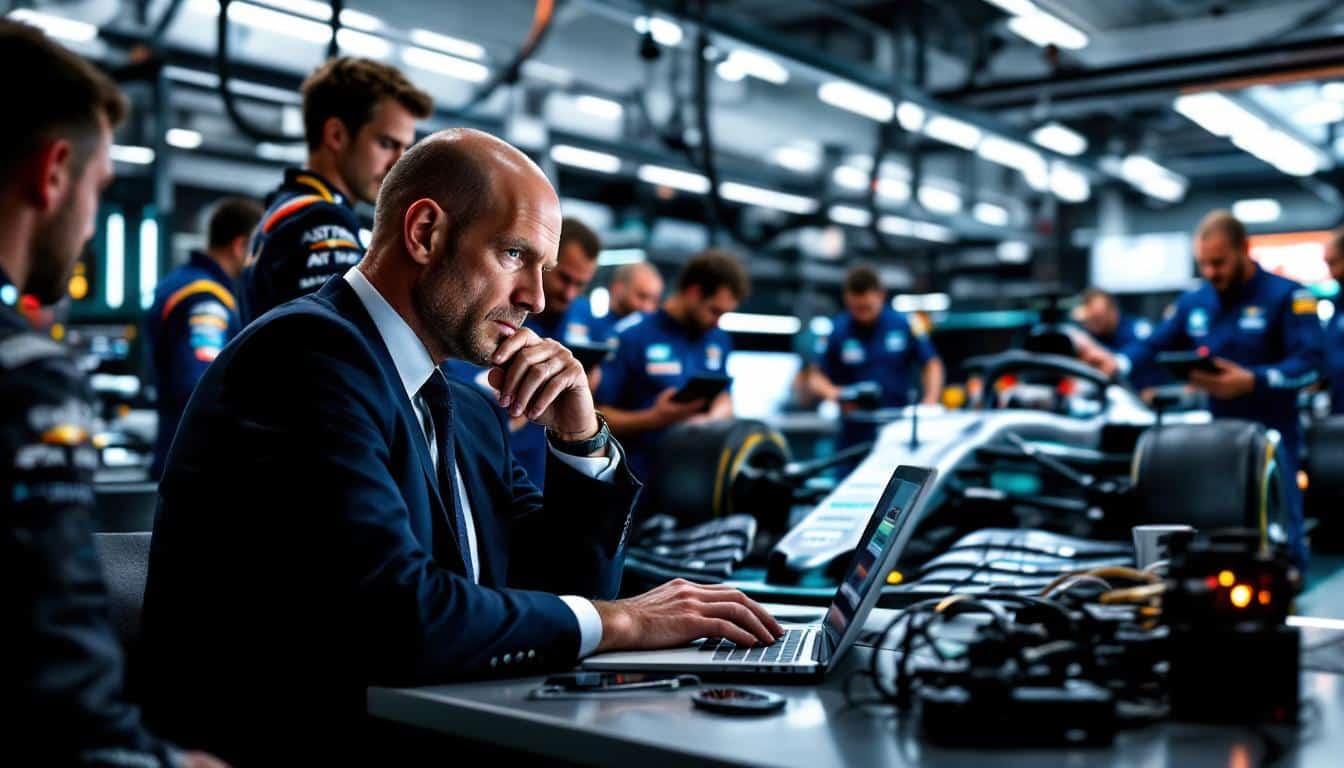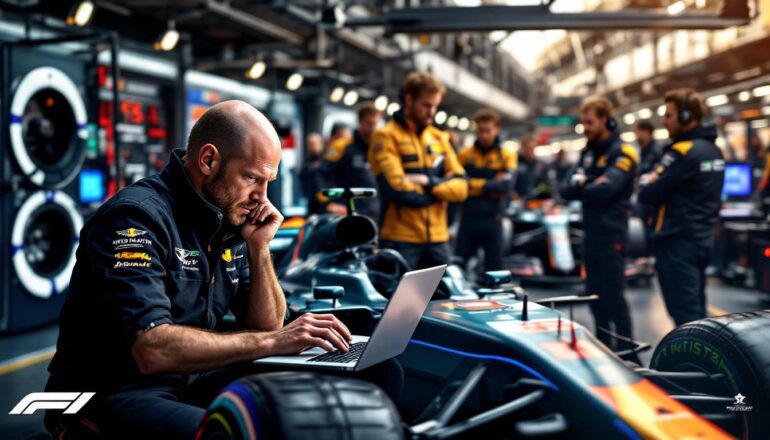Rev up your engines, because the race for dominance in Formula 1 has taken an intriguing twist. The heat between design philosophies and ambitious predictions is simmering, fueled by two key figures in the industry. With the spotlight firmly on Aston Martin’s development, Andy Cowell is ready to prove critics wrong.
Adrian Newey, the mastermind behind many championship-winning cars, recently stirred the pot with comments suggesting a lengthy road ahead for Aston Martin’s design team. He pinpointed concerns regarding data correlation with their simulation technology, warning that fixing the issues might take “probably a two-year project.” But Cowell, the team’s CEO and principal, isn’t one to back down from a challenge.
Instead, he sees Newey’s observations as a catalyst for progress. In a conversation on the James Allen on F1 podcast, Cowell expressed determination, stating that the team is ready to leap over high hurdles. Cowell and his team are not just awaiting improvement; they are actively embracing high standards and setting their sights on revolutionizing their performance within months, not years. The competitive spirit is palpable, and it’s clear that the Aston Martin F1 Team is rallying to turn predictions upside down.
With a rich history and collaborative mindset, Cowell and Newey are joining forces again after years apart, ready to tackle the intricate dynamics of race car design head-on. The synergy between their expertise sets the stage for a thrilling and transformative journey in the sport.

Adrian Newey, known as one of the brightest minds in the world of Formula 1, has recently directed his attention towards Aston Martin’s performance, setting the scene for a battle of wits and engineering prowess. The reputation of Newey precedes him, as he is known for his strategic insights and his ability to push the boundaries of car design. His challenge to Aston Martin goes beyond mere words; it encapsulates a deep understanding of engineering, data analysis, and competitive racing dynamics. To grasp the full implication of Newey’s comments, it’s essential to understand the context and the potential ramifications they hold for Aston Martin.
Newey’s assertion regarding the challenges faced by Aston Martin’s design team stems from a close examination of their current facilities and technology. He’s highlighted that, despite having a state-of-the-art headquarters in Silverstone, there remains a significant gap in data correlation with their simulator. These observations serve as a catalyst for the Aston Martin team, igniting a sense of urgency and igniting their competitive spirit. As Newey himself noted, the resolution of these underlying issues could take “probably a two-year project in truth.” This prediction has not gone unnoticed, and the response from Aston Martin’s team principal, Andy Cowell, reveals their determination to accelerate progress.
Cowell has emphasized that such predictions are not taken lightly. Instead of succumbing to the pressure, the team views Newey’s words as an invitation to challenge themselves. With a strong dedication to improvement, Cowell insists it’s not about waiting years to rectify these issues. The spirit within the Aston Martin team is one of resilience, as they resolve to transform Newey’s two-year timeline into a matter of months. By setting high standards and fostering an environment of collective ambition, Aston Martin aims to showcase their capacity for rapid adaptation.
Moreover, Cowell’s strategic collaboration with Newey hinges on a shared ambition for performance elevation. Their mutual history, dating back to when Cowell worked at McLaren, provides a strong foundation for open dialogue regarding design improvements. The interplay between their philosophies creates a collaborative atmosphere where innovation can flourish. Their combined efforts reflect a profound understanding of both technological capabilities and team dynamics, essential for success in the cutthroat arena of Formula 1.
How is Adrian Newey’s critique reshaping Aston Martin’s engineering strategies?
Adrian Newey’s critique serves not merely as a challenge but as a vital learning experience for Aston Martin’s engineering personnel. His insights point to a critical need for improvement in data reliability, specifically mentioning the loop simulator as an area requiring urgent attention. This critique propels the design team to reevaluate their processes and methodologies, fostering an environment where feedback is valued, and evolution is expected.
The implications of Newey’s comments extend to the design philosophy at Aston Martin. Cowell has mentioned that “everything that we’re doing can improve and needs to improve.” This assertion emphasizes a cultural shift within the team: embracing a growth mindset rather than adhering to traditional approaches. The Aston Martin’s design team recognizes the need to adapt swiftly to Newey’s standards, which effectively raises the stakes in terms of performance and innovation.
In response to Newey’s forecast, Aston Martin’s team is propelled by a shared vision to outperform expectations. Cowell emphasizes that the entire organization—from engineers to management—is set on proving that they can achieve results in a faster timeframe than predicted. This collective mindset fosters a competitive spirit that not only improves the current performance trajectory but also invigorates the team dynamics. By rallying behind Newey’s challenge, Aston Martin transcends their previous limitations, driven by an ambitious goal: to turn months into an achievable timeline.
Moreover, the integration of new design strategies may also benefit from the collaborative dynamics between Cowell and Newey. The rapid evolution in technology often requires a nimble approach, and Adrian Newey’s historical expertise and unconventional problem-solving methods make him an invaluable asset for Aston Martin’s ongoing development. By tapping into Newey’s wealth of knowledge, Aston Martin’s design team can explore innovative solutions to complex engineering challenges, ensuring they remain competitive.
What role does team dynamics play in overcoming the strategic challenges posed by Newey?
Team dynamics are essential to successfully overcoming the strategic challenges laid out by Adrian Newey. The collective mindset of Aston Martin’s staff serves as the backbone in their pursuit of elevating the car’s performance in the wake of Newey’s critique. The involvement of every team member, ranging from engineers to management staff, is crucial for collectively navigating the complex path toward improvement. Cowell’s insistence on shared accountability instills a culture of collaboration that is indispensable in a competitive landscape like Formula 1.
Moreover, creating a unified front ensures that every voice within the organization is heard, promoting the free exchange of ideas, strategies, and innovations. As Cowell reflected on his relationship with Newey, the importance of open communication cannot be overstated. Their dynamic fosters an atmosphere where suggestions can be explored without hesitation. This shared commitment to accountability and growth strengthens Aston Martin’s resilience, reinforcing their resolve to rise to Newey’s challenge.
In the face of setbacks, a cohesive team can find inspiration in adversity. Cowell’s leadership encourages everyone at Aston Martin to view Newey’s predictions as motivating rather than discouraging. By embracing a culture that celebrates internal competition and ambitious goals, the team can achieve remarkable breakthroughs and enhanced performance levels. Each member of the team becomes an integral part of the overall success, enhancing the design process and fueling innovation.
In conclusion, Adrian Newey’s strategic challenges are not isolated critiques; they are instrumental in reshaping Aston Martin’s engineering ethos. His remarks push the boundaries of engineering expectations and highlight the significance of effective teamwork. Coupled with Cowell’s commitment to a high-performance culture, Aston Martin stands on the cusp of redefining their approach in Formula 1, ready to demonstrate their capability in racing’s most demanding environment. Together, they aim to transform every challenge into an opportunity for growth, set on a trajectory toward unrivaled performance.
How will the integration of Honda engines impact Aston Martin’s advancements?
As Aston Martin gears up for their engine switch to Honda in 2026, the impending transition adds a new layer of complexity to the strategic challenges posed by Newey’s comments. The integration of a new power unit necessitates careful planning, innovation, and collaboration among the entire racing operation. For Cowell, his role in overseeing the intricacies of this transition will be pivotal, particularly given his previous leadership experience with Mercedes’ High Performance Powertrains division.
Understanding the nuances of the hybrid engine is essential for Cowell and his team. He recognizes that the responsibility of creating an effective power unit rests with Honda, but they must stay proactive to ensure seamless integration. Cowell’s view is that “the best way of coming up with a common currency is having a common currency, and that’s lap time.” This encapsulates the strategic imperative for Aston Martin: to align their engineering capabilities with Honda’s offerings and optimize performance across the board.
There is a pressing need for collaboration between Aston Martin’s engineering team and Honda engineers. By fostering a rapport that facilitates effective communication, both parties can navigate potential challenges and synergize their efforts. Cowell’s background allows him to bridge the gap between the two organizations, providing insights that may help install a shared understanding of objectives.
The essence of a successful transition lies in unified performance benchmarking. As the teams work toward enhancing lap times, they must correlate their findings and insights to drive progress. Shared objectives provide momentum to overcome hurdles, making the challenges presented by Newey increasingly attainable. With robust lines of communication, Aston Martin can translate the vision of their new power unit into tangible improvements on the track.
Additionally, the data gleaned from the collaboration can be utilized to optimize existing dynamics, driving both engine power and vehicle development. The faster Aston Martin can adapt to the integration of Honda engines, the more they can turn challenges into opportunities. This adaptable approach will underpin their success, allowing Aston Martin to continue evolving in a sport where every millisecond counts.


